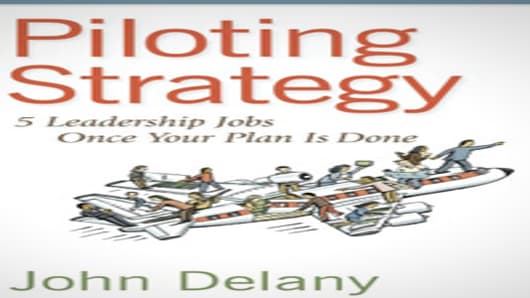GUEST AUTHOR BLOG by John Delany, author of "Piloting Strategy: 5 Leadership Jobs Once Your Plan Is Done."
Avon. Dell. The Chicago Cubs. The City of Chicago. HP. The University of Virginia. The San Diego Padres.
Each organization has a new pilot. Each pilot has a major challenge on his or her hands. Each leader must oversee the re-building of his or her respective planes in the worst mix of headwinds, crosswinds, tailwinds, snow sleet, ice, hail and blinding sun - that any business pilot alive today can remember.
No landing and taxiing to the hangar. Not even a touch-and-go landing. Airborne re-supply only (fuel and crew). Keep flying, get the right crew on board, and come up with a plan to fix the plane, make course corrections, rebuild it and get the rebuilt plane to its new destination.
Today’s business leaders greatly increase their odds of getting the plane rebuilt in these horrendous flying conditions by focusing on and constantly making adjustments to five key flight plan vectors.
The five vectors for rebuilding in mid-flight correspond to what Piloting Strategy calls Strategy Implementation. It’s the time between Strategy Formulation (creating the plan) and Strategy Execution (directing and managing a totally new business model).
In other words, it’s the messy, rebuilding period that takes an organization from the old reality to new.
Vector One: Talk Strategy. First, the leader and the crew must discuss the new strategy that must be implemented every day. No going back to the ‘day job’ after the plan is done. Strategy implementation is the new day job for all senior leaders. Talking strategy every day means constantly interpreting plan implementation in light of the most recent weather change and deciding what needs to be done next.
"Strategy implementation is the new day job for all senior leaders. Talking strategy every day means constantly interpreting plan implementation in light of the most recent weather change and deciding what needs to be done next."
Vector Two: Begin New Work. One of the first course corrections is discussing what new work needs to be done to give lift to the new strategy. New work also involves stopping old work that now is “off strategy.” Stopping old work is in many ways more difficult that starting new work. It’s both the starting of new work and the stopping of old work that rebuilds the plane.
Vector Three: Organize Authority. This vector is not about people. It’s about positions and which positions have decision-making authority over which work activities. With vectors two and three, leaders determine how the new organization will look and work. With the rebuilding metaphor, the leader figures out what needs rebuilding and which roles have responsibility for each part of the rebuilding process.
Vector Four: Manage People. Vectors two and three together create the roles the leader needs to fill. In this step, the roles are filled. Here is where the hard conversations occur: who stays, who goes, who gets a new job, what new crew members are brought on board.
Vectors two, three and four are all managed and executed in close coordination. Together they create one of the key guidelines for rebuilding in the air: Staff the organization. Don’t organize the staff.
Vector Five: Recognize and Reward. A lot of hard work goes into directing, managing and adjusting the first four vectors. In this vector, outstanding pilots make sure they recognize and reward the outstanding crew members who make the rebuilt plane a reality.
In working with outstanding leaders, I’ve noticed that a key competency is their facility for managing all five vectors at the same time. Their reward has been piloting a new, faster, more productive plane to new destinations. In business parlance, they have enjoyed record years shortly after the trial-by-rebuilding was behind them and their renovated organizations were in full execution mode.
Author of "Piloting Strategy: 5 Leadership Jobs Once Your Plan Is Done,", John Delany is founder and president of Giraffe, LLC, which facilitates strategy development and implementation programs. Prior to starting Giraffe, John held various leadership positions at Arthur Andersen, Sears, and Fallon Advertising. A frequent writer and speaker, he has a Ph.D. from Yale and a B.A. from Brown. For more information on Piloting Strategy, visit www.pilotingstrategy.com
Email me at bullishonbooks@cnbc.com—
And follow me on Twitter @BullishonBooks

